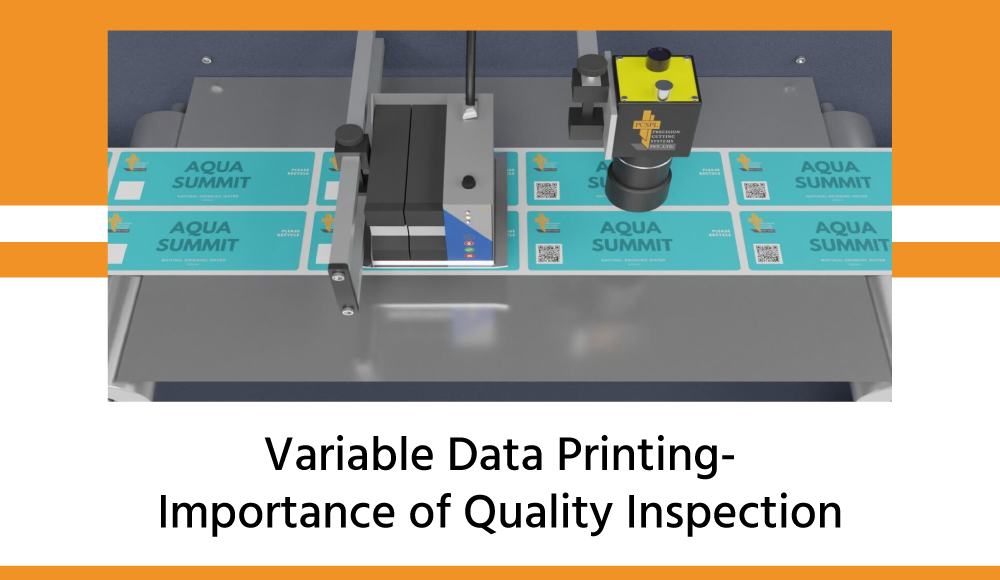
- Pixelwise Technology
- Apr 14, 2023
- Label inspection
The traditional approach of creating promotional materials such as brochures, flyers, and collateral for businesses is now a thing of the past. The advent of digital printing technology and variable data printing technology has revolutionized the way businesses can produce customized media. With these advanced tools, users can easily create personalized and unique content that is tailored to individual customers.
This allows businesses to better engage with their target audience, resulting in more effective marketing campaigns. As a result, businesses can take advantage of the benefits of digital printing technology such as variable data printing software and print inspection systems to produce high-quality promotional materials that are both cost-effective and personalized.
This guide will explain variable data printing (VDP), how it functions, and its four key advantages. The focus would be on understanding data inspection, and better understanding how variable data printing can benefit your company in various ways.
Unlock personalized success with Variable Data Printing! Elevate your brand — Get a quote!
A] What Is Variable Data Printing?
Variable data printing (VDP) is a digital printing technology that customizes printed materials with unique content, images, or data for each print piece. This means that each printed piece can be personalized based on individual preferences, demographics, or other specific information.
In variable data printing, the content of each printed piece is generated from a database or other digital source. For example, a direct mail campaign might use VDP to personalize each piece with the recipient’s name, address, and other information, as well as different images or offers on the recipient’s demographic, variable of an inspection, or past purchase history.
VDP can be used for a wide range of printed materials, including direct mail pieces, brochures, labels, and packaging. The variable data printer can help to improve response rates, increase customer engagement, and enhance the overall effectiveness of printed marketing materials.
B] Two Different Types Of Variable Data Printing
1. Simple Variable Data Printing
In this type, the variable data used in printing is limited to simple changes such as names, addresses, or other basic data print. This type of VDP is used for direct mail pieces, invoices, and other similar materials where personalized information or inspecting variable data needs to be included.
2. Complex Variable Data Printing
This type of VDP involves using more complex data sets to create unique and personalized printed pieces. Complex VDP is often used for marketing campaigns and other materials where high personalization is required to engage the audience.
C] Importance of Quality Inspection in Variable Data Printing
Quality inspection is an important aspect of variable data printing (VDP) because the accuracy and consistency of the variable data are critical to the success of the printed piece.
Here are some reasons for the importance of inspection in variable data printing:
1. Ensuring Accuracy
VDP involves using complex data sets to create unique and personalized printed pieces. Understanding the importance of data in variable data printing is crucial to generating maximum accuracy from the finished product. By taking into consideration the accuracy and consistency of the data used in the printing process, businesses can create highly personalized and effective marketing materials that resonate with their target audience.
2. Maintaining Consistency
Consistency is key in variable data labels to ensure that all printed pieces have the same quality and accuracy of data. The quality inspection helps to identify any inconsistencies in the printing process and rectify them before the final product is delivered.
3. Protecting Brand Image
By ensuring that the printed material is of high quality and accuracy, quality inspection tech can enhance the brand’s perception in the minds of the customers. This can help to build trust and loyalty, which are important factors for protecting a brand’s image.
D] How to Ensure Quality Inspection in Variable Data Printing
Ensuring quality inspection in variable data printing (VDP) involves several key steps. Here are some best practices for ensuring quality inspection in VDP:
1. Establishing Inspection Protocols
Define clear quality standards for printing variable data. This should include standards for data accuracy, format, and other key factors. Make sure these standards are communicated clearly to all stakeholders involved in the printing process.
2. Implementing Automated Inspection Tools
Implementing automated inspection tools is a crucial step in ensuring quality inspection in variable data printing. These tools can help identify and prevent errors in real-time, ultimately saving time and money while ensuring the highest level of quality.
3. Using professional inspection services
Professional inspection services have specialized expertise and experience in VDP quality inspection. They can provide valuable insights into best practices, industry standards, and emerging trends in the VDP space.
E] Challenges and Solutions in Quality Inspection of Variable Data Printing
1] Common Challenges in Inspection
- Verification Of Data Accuracy
One of the primary challenges in VDP quality inspection is verifying the accuracy of the data being printed. Since variable data label printing involves printing customized data, it is crucial to ensure that the right data is being printed on the right page.
- Consistency In Print Quality
Consistency in print quality is essential to ensure that the printed materials look professional and meet the required standards.
- Detection Of Printing Errors
Printing errors such as streaks, smudges, and color variations can negatively impact the quality of printed materials.
- Time-Consuming Inspection Process
VDP involves printing customized data, which makes the inspection process time-consuming. Thus, you must be aware of what is variable inspection to gauge an understanding on the time and efforts required. This can help in better planning.
2] Solutions to Overcome Challenges
- Automated Data Verification
Automated data verification software can verify the accuracy of the data being printed. The software can compare the printed data against the original data source and flag any discrepancies.
- Quality Control Checks
Quality control checks can ensure consistency in print quality. These checks involve monitoring the printing process to ensure that the printer is functioning correctly and the print quality is consistent.
- Automated Inspection Systems
Automated inspection systems can detect printing errors. These systems use sensors and cameras to inspect the printed materials for any defects or errors. If any errors are detected, the system can stop printing to prevent further defects.
- High-Speed Inspection Systems
High-speed variable data printing and inspection systems can inspect VDP materials quickly. These systems can process large volumes of printed materials and identify any defects or errors within seconds.
3] Best Practices for Quality Inspection
- Use Automated Inspection Systems
Automated inspection systems can help identify printing errors, such as streaks, smudges, and color variations, quickly and accurately. The machine vision system can also detect missing or incorrect data, ensuring that the printed materials are accurate.
- Perform Regular Calibration And Maintenance.
Regular calibration and maintenance of printing equipment are essential to maintain consistent print quality. Calibration and maintenance should be performed according to the manufacturer’s recommendations.
- Train Quality Inspection Personnel
Quality inspection personnel should be trained in using inspection equipment and software. They should also be trained to identify and report any defects or errors.
- Conduct Sample Testing
Conducting sample testing of printed materials can help identify any quality issues before printing large quantities. Sample testing should be performed using the same equipment and procedures as the actual printing process.
- Monitor And Track Quality Metrics.
Monitoring and tracking quality metrics, such as defect rates and inspection results, can help identify areas for improvement in the printing process. Quality metrics can also measure the effectiveness of quality control procedures.
- Continuously Improve Quality Control Procedures.
Continuously improving quality control procedures can help ensure that the printed materials consistently meet the required quality standards. Quality control procedures should be reviewed and updated regularly to incorporate new technologies and best practices.
Unlock personalized success with Variable Data Printing! Elevate your brand — Get a quote!
F] Conclusion
Overall, Variable Data Printing is a powerful tool for businesses and organizations to create personalized printed materials that can help to improve engagement, response rates, and overall marketing effectiveness.
To get started with variable data printing, you need a digital press. VDP can be helpful in your company if you want to streamline the printing of documents while also being creative and customizing each printed piece of material.
Pixelwise Technology LLP. Offers products in the range of variable 1D & 2D code prints. The demand for these services is growing since there is a need to have unique label codes. These products make it possible to have unique codes that are readability compliant, sequential, and can also help generate reports.
If you require advanced variable data printing services, do not hesitate to contact Pixelwise Technology LLP. Our team is equipped with the necessary expertise and technology to meet your printing needs with confidence.





